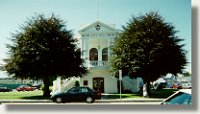 |
City Hall - SOCIAL HISTORY OF BUILDING |
 |
City Hall - SOCIAL HISTORY OF BUILDING |
 BIBLIOGRAPHY SITE CONTENTS LOCATION MAP MEASURED DRAWINGS TEACHER'S CORNER ARCHITECTURAL INFORMATION DESIGN TEAM HOME |
For many small towns in Canada, expansion and changes introduced the need to build a city hall. From the late 19th century to the early 20th century, specialized departments to supervise municipal services were necessary to aid the growing population. This occurred across Canada. Chilliwack was one of these towns that experienced extensive growth in the early 1900's. The implementation of the telephone and electricity in 1908 and the railway from 1910 to 1912, are signs of the town's need to accommodate its growing urban community and to deal with the problems that came with expansion. This led to the building of Chilliwack's City Hall, from 1910 to 1912.
By the turn of the century, a feeling of optimism and confidence filled the town of Chilliwack(Julie Hicks and Robert Barnes. Chilliwack Museum Site: A Site History and Landscape Plan. p. 6). Within less than fifty years, the bare valley had become a series of expansive farms (Julie Hicks and Robert Barnes. Chilliwack Museum Site: A Site History and Landscape Plan. p. 6) In the 1860's, Chilliwack valley became desired land for maintaining agriculture and livestock. Within 20 years, farming, dairying, and lumbering had prospered and became an essential part of the livelihood of the region. Due to the initial prosperity, newspaper announcements from the Board of Trade tried to attract immigrants to the valley, encouraging them to settle in a land that was based on the farming industry. As immigrants settled in the area, hundreds of land parcels were bought and later subdivided. This form of distributing land brought more wealth to the already established families. Meanwhile the newly arrived immigrants were having problems paying off their taxes (Julie Hicks and Robert Barnes. Chilliwack Museum Site: A Site History and Landscape Plan. p. 6). This led to the establishment of a local monied social class.
Allen Casey Wells was a member of this monied class. He was one of the first pioneers to arrive in Chilliwack in 1865(Julie Hicks and Robert Barnes. Chilliwack Museum Site: A Site History and Landscape Plan. p.7) and founded the first creamery on his farm, "Edenbank" (Julie Hicks and Robert Barnes. Chilliwack Museum Site: A Site History and Landscape Plan. p. 7). It is through Wells, that the well-known architect, Thomas Hooper was hired to design the building. Hooper's design was under the supervision of the contractor, J.C. Robertson. The exterior of the building was constructed almost entirely of poured and block concrete. Due to the fires of the wooden false-fronted buildings in 1906
|
|
 |
 |
 |
 |
| Last updated 31 August 1998. This digital collection was produced under contract to the Canada's Digital Collections Program, Industry Canada. Produced by Canada's Digital Collections Team. Content provided by BC Heritage Trust and Heritage Branch, Province of British Columbia. |